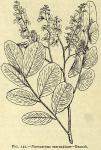 The spontaneously inspissated juice of Pterocar'pus marsu'pium (Roxburgh).
The spontaneously inspissated juice of Pterocar'pus marsu'pium (Roxburgh).
BOTANICAL CHARACTERISTICS.—A leafy tree 40 to So feet high, with reddish-brown bark. Leaflets 5 to 7, coriaceous, dark green, shining, 3 to 5 inches long. Flowers yellowish-white. Legume woody, indehiscent.
SOURCE.—East Indies. We have several varieties other than the Malabar (East India), the official kind as described above namely, African or Gambia kino (P. erinaceus), Palas or Bengal kino (Butea frondosa), Botany Bay or Eucalyptus kino (E. amygdalina), from Australia, and West Indian or Jamaica kino (Coccoloba uvifera). These all furnish extractives known as kino.
A new kind of kino from the juice of the bark of several kinds of Asiatic Myristica has been noticed, differing from the Malabar by containing, in the crude state, calcium tartrate. By this characteristic it may easily be distinguished from the official and other kinos of the market.
DESCRIPTION OF DRUG.—Small, dark reddish-brown, shining, angular fragments, much lighter and nearly transparent in thin layers. Adheres to the teeth when chewed, and colors the saliva a deep red; odorless; taste sweetish and astringent. The powder is of a brownish-red color.
Powder.—Elements of: See Part iv, Chap. I, B.
CONSTITUENTS.—Kino-tannic acid (colored black-green by ferric salts, in neutral solution; violet by ferrous salts), kinoin, neutral crystalline prisms, pyrocatechin, kino-red, pectin, and ash. Ash, not exceeding 3 per cent.
Preparation of Kinoin.—Boil kino with dilute HCl and agitate clear solution with ether. Evaporate off the ether. Heating this to 266°F., an insoluble amorphous kino-red is obtained.
Pyrocatechin results from the dry distillation of kino, or is obtained by treating kino with ether.
ACTION AND USES.—A powerful astringent. Dose: 8 to 30 gr. (0.5 to 2 Gm.).
OFFICIAL PREPARATION.
Tinctura Kino (5 per cent.), Dose: 1 to 2 fl. dr 4 to 8 mils) .

